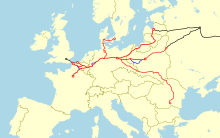|
Nord Express
 The Nord Express (Northern Express) was a long-distance international express train which for more than a century connected Paris with first Russia and later Poland, the Baltic states and Scandinavia. In its heyday before the First World War, it was considered the ultimate luxury train in Europe. Introduced in 1896 by the Compagnie Internationale des Wagons-Lits, which operated sleeping-cars, dining cars and trains deluxe all over Europe, including the Orient Express, it connected Paris and Saint Petersburg. After World War I and the Russian Revolution, the train's route was shortened to Warsaw and Riga instead of Saint Petersburg. And after World War II the "Iron Curtain" diverted the train's route further to Stockholm and Oslo, until air travel caused the end to this famous train. Although the Nord Express has received significantly less attention than the Orient Express, it is one of the CIWL's best-known luxury trains and has been featured in a number of artistic works. HistoryBackground In 1874, the Belgian civil engineer and railway entrepreneur Georges Nagelmackers founded the Compagnie Internationale des Wagons-Lits (lit. International Sleeping-Car Company, also CIWL). The purpose was to establish a network of luxurious long-distance passenger trains across the European continent inspired by the Pullman night trains of the United States. As one of these train connections, the CIWL wanted to establish a direct cross-continental link between Saint Petersburg and Lisbon to connect with ocean liners to America. However, this concept proved too complex and could not be realized. In turn, two separate connections arose: the Sud Express from Paris to Lisbon and the Nord Express from Paris to Saint Petersburg.[1] Before World War I On 9 May 1896, the Nord Express departed for the first time from the French to the Russian capital. This train service enabled people to travel across Europe in what was, by the standards of the time, a very fast and comfortable manner. For the operation of the Nord Express, the CIWL had to close contracts and timetable agreements with fourteen railway administrations, including nine Prussian administrations, as well as the ferry service across the English Channel between Dover and Ostend. The train left Paris and Ostend (with connection from London) and travelled via Brussels, Cologne, Hanover, Berlin, Königsberg (now Kaliningrad) and Dvinsk (now Daugavpils) to Saint Petersburg. Passengers to and from Russia had to change once in East Prussia at the German/Russian border because Russian railway tracks are of a wider gauge than those in Western Europe. In Paris there was a connecting service to the Sud Express (Southern Express) to Lisbon. Interwar period After World War I and the Russian Revolution the train's route was shortened to Warsaw and Riga instead of Saint Petersburg. Riga joined the connection in 1923, with a separate Riga–Moscow line introduced as well. Post-War Period After World War II the "Iron Curtain" divided Europe, and the initially luxury and since 1951 ordinary night train's route was diverted further from Paris via Hamburg and Copenhagen to Stockholm and Oslo. The emergence of air travel and high-speed rail caused the end to this famous train. In 2007 it was shortened further and such that it ran between Paris and Hamburg, taking 10.5 hours. In the artsThe Nord Express has received significantly less attention than the Orient Express. Nevertheless, it is one of the CIWL's best-known luxury trains and has been featured in a number of novels and films:
ReferencesCitations
Bibliography
See also |